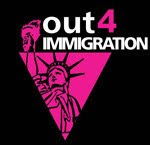 With President Obama’s signature on the repeal of “Don’t Ask, Don’t Tell” this morning, 2010 ends on a high note for gay rights. With the defeat of the DREAM Act in the Senate last week, the year ends on a low note for comprehensive immigration reform (CIR).
With President Obama’s signature on the repeal of “Don’t Ask, Don’t Tell” this morning, 2010 ends on a high note for gay rights. With the defeat of the DREAM Act in the Senate last week, the year ends on a low note for comprehensive immigration reform (CIR).
Same-sex binational couples have long been caught in the vortex of these two important movements in American politics. We are, first and foremost, gay and lesbian, yet at least half of us are first-generation immigrants. The other half of us though are American citizens and US permanent residents.
The citizens among us (second-class LGBT citizens that we are) are denied thousands of rights – including the right to sponsor our same-sex foreign-born partner for immigration purposes.
As far as political movements go, same-sex binational couples are a small group. In spite of efforts to estimate that there are far more of us than 36,000 couples – 36,000 remains the accepted figure. Split that in half and you have 18,000 gay and lesbian American citizens at any one time facing the unconscionable – leave the country you love to be with the person you love, or live a life apart from your life partner – which is no kind of life at all. (By contrast, it’s estimated that 2 million children of undocumented workers would have benefited from the DREAM Act.)
With the momentum shift that’s occurred with DADT repeal, it’s time for same-sex binationals to remember why we are being discriminated against in the first place. It is not because half of us are immigrants. It is because all of us are gay and lesbian. US immigration has no problem with opposite-sex binational couples. In fact, it is the heterosexual American citizen’s inalienable right to marry the person he or she loves and build a life with that person in the United States – whether that person is another American, or from another country. (Read more)

Kathy Drasky regularly writes about online culture. Her marketing and communications work with the ANZA Technology Network, Advance Global Australians and with various Australians and Australian enterprises has led to at least a dozen trips Down Under.
An accomplished digital photographer, her photos have appeared in 7×7 Magazine, the San Francisco Chronicle and Google Schmap.








